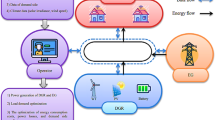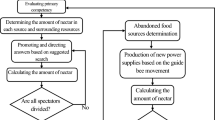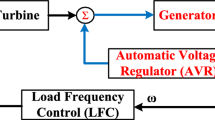Abstract
This paper proposes a new methodology for solving the coordination problem of DOCRs based on multi-objective grey wolf optimizer and fuzzy logic decision-making. In addition to the conventional objective function, a new objective function which aims to minimize the discrimination time between primary and backup relays is proposed. Moreover, the conventional objective function related to minimizing the total operating time of primary and backup relays is considered. The feasibility and performance of the proposed methodology for solving the coordination problem of DOCRs are investigated using two different systems (8-bus system and IEEE-30 bus system). The proposed methodology is compared with other reported methods. The results prove the viability and effectiveness of the proposed methodology to solve the DOCR coordination problem without any miscoordination between primary and backup relays.









Similar content being viewed by others
References
Abdelaziz AY, Talaat H, Nosseir A, Hajjar AA (2002) An adaptive protection scheme for optimal coordination of overcurrent relays. Electr Power Syst Res 61:1–9
Albasri FA, Alroomi AR, Talaq JH (2015) Optimal coordination of directional overcurrent relays using biogeography-based optimization algorithms. IEEE Trans Power Deliv 30:1810–1820
Al-Roomi AR, El-Hawary ME (2017) Optimal coordination of directional overcurrent relays using hybrid BBO-LP algorithm with the best extracted time-current characteristic curve. In: 2017 IEEE 30th Canadian conference on electrical and computer engineering (CCECE), pp 1–6
Amraee T (2012) Coordination of directional overcurrent relays using seeker algorithm. IEEE Trans Power Deliv 27:1415–1422
Baghaee HR, Mirsalim M, Gharehpetian GB, Talebi HA (2018) MOPSO/FDMT-based Pareto-optimal solution for coordination of overcurrent relays in interconnected networks and multi-DER microgrids. IET Gener Transm Distrib 12:2871–2886
Bedekar PP, Bhide SR, Kale VS (2009) Optimum time coordination of overcurrent relays in distribution system using Big-M (penalty) method. WSEAS Trans Power Syst 4:341–350
Benabid R, Boudour M, Abido M (2009) Optimal location and setting of SVC and TCSC devices using non-dominated sorting particle swarm optimization. Electr Power Syst Res 79:1668–1677
Birla D, Maheshwari RP, Gupta H (2006) A new nonlinear directional overcurrent relay coordination technique, and banes and boons of near-end faults based approach. IEEE Trans Power Deliv 21:1176–1182
Bouchekara H, Zellagui M, Abido M (2017) Optimal coordination of directional overcurrent relays using a modified electromagnetic field optimization algorithm. Appl Soft Comput 54:267–283
Chelliah TR, Thangaraj R, Allamsetty S, Pant M (2014) Coordination of directional overcurrent relays using opposition based chaotic differential evolution algorithm. Int J Electr Power Energy Syst 55:341–350
Costa MH, Saldanha RR, Ravetti MG, Carrano EG (2017) Robust coordination of directional overcurrent relays using a matheuristic algorithm. IET Gener Transm Distrib 11:464–474
El-Fergany AA, Hasanien HM (2017) Optimized settings of directional overcurrent relays in meshed power networks using stochastic fractal search algorithm. Int Trans Electr Energy Syst 27:e2395
Ezzeddine M, Kaczmarek R, Iftikhar M (2011) Coordination of directional overcurrent relays using a novel method to select their settings. IET Gener Transm Distrib 5:743–750
Gokhale S, Kale V (2014) Application of the Firefly algorithm to optimal over-current relay coordination. In: 2014 international conference on optimization of electrical and electronic equipment (OPTIM), pp 150–154
Jiang H, Zhan J, Chen D (2018) Covering based variable precision (I, T)-fuzzy rough sets with applications to multi-attribute decision-making. IEEE Trans Fuzzy Syst 27:1558–1572. https://doi.org/10.1109/tfuzz.2018.2883023
Korashy A, Kamel S, Youssef A-R, Jurado F (2018) Modified water cycle algorithm for optimal direction overcurrent relays coordination. Appl Soft Comput 74:10–25
Liu S, Zhang D, Liu X, Zhang T, Gao J, Cui Y (2019a) Dynamic analysis for the average shortest path length of mobile ad hoc networks under random failure scenarios. IEEE Access 7:21343–21358
Liu X, Zhang D, Yan H, Cui Y, Chen L (2019b) A new algorithm of the best path selection based on machine learning. IEEE Access 7:126913–126928. https://doi.org/10.1109/ACCESS.2019.2939423
Mirjalili S, Mirjalili SM, Lewis A (2014) Grey wolf optimizer. Adv Eng Softw 69:46–61
Mirjalili S, Saremi S, Mirjalili SM, Coelho LDS (2016) Multi-objective grey wolf optimizer: a novel algorithm for multi-criterion optimization. Expert Syst Appl 47:106–119
Mohammadi R, Abyaneh HA, Rudsari HM, Fathi SH, Rastegar H (2011) Overcurrent relays coordination considering the priority of constraints. IEEE Trans Power Deliv 26:1927–1938
Moravej Z, Adelnia F, Abbasi F (2015) Optimal coordination of directional overcurrent relays using NSGA-II. Electr Power Syst Res 119:228–236
Radosavljević J, Jevtić M (2016) Hybrid GSA-SQP algorithm for optimal coordination of directional overcurrent relays. IET Gener Transm Distrib 10:1928–1937
Raj M, Semwal VB, Nandi G (2019) Multiobjective optimized bipedal locomotion. Int J Mach Learn Cybern 10:1997–2013
Rajput VN, Pandya KS (2017) Coordination of directional overcurrent relays in the interconnected power systems using effective tuning of harmony search algorithm. Sustain Comput Inform Syst 15:1–15
Semwal VB, Raj M, Nandi GC (2015) Biometric gait identification based on a multilayer perceptron. Robot Auton Syst 65:65–75
Semwal VB, Mondal K, Nandi GC (2017) Robust and accurate feature selection for humanoid push recovery and classification: deep learning approach. Neural Comput Appl 28:565–574
Semwal VB, Gaud N, Nandi G (2019) Human gait state prediction using cellular automata and classification using ELM. In: Machine Intelligence and Signal Analysis, ed. Springer, pp 135–145
Singh DK, Gupta S (2012) Use of genetic algorithms (GA) for optimal coordination of directional over current relays. In: 2012 Students Conference on Engineering and Systems (SCES), pp 1–5
Singh M, Panigrahi B, Abhyankar A (2013) Optimal coordination of directional over-current relays using Teaching Learning-Based Optimization (TLBO) algorithm. Int J Electr Power Energy Syst 50:33–41
Thangaraj R, Pant M, Deep K (2010) Optimal coordination of over-current relays using modified differential evolution algorithms. Eng Appl Artif Intell 23:820–829
Tjahjono A, Anggriawan DO, Faizin AK, Priyadi A, Pujiantara M, Taufik T et al (2017) Adaptive modified firefly algorithm for optimal coordination of overcurrent relays. IET Gener Transm Distrib 11:2575–2585
Urdaneta AJ, Restrepo H, Marquez S, Sanchez J (1996) Coordination of directional overcurrent relay timing using linear programming. IEEE Trans Power Deliv 11:122–129
Zeineldin H, El-Saadany E, Salama M (2006) Optimal coordination of overcurrent relays using a modified particle swarm optimization. Electr Power Syst Res 76:988–995
Zhang D (2012) A new approach and system for attentive mobile learning based on seamless migration. Appl Intell 36:75–89
Zhang D, Zhang X (2012) Design and implementation of embedded un-interruptible power supply system (EUPSS) for web-based mobile application. Enterp Inf Syst 6:473–489
Zhang D, Zhu Y, Zhao C, Dai W (2012) A new constructing approach for a weighted topology of wireless sensor networks based on local-world theory for the Internet of Things (IOT). Comput Math Appl 64:1044–1055
Zhang D, Li G, Zheng K, Ming X, Pan ZH (2013) An energy-balanced routing method based on forward-aware factor for wireless sensor networks. IEEE Trans Ind Inform 10:766–773
Zhang D, Wang X, Song X, Zhao D (2014) A novel approach to mapped correlation of ID for RFID anti-collision. IEEE Trans Serv Comput 7:741–748
Zhang D, Wang X, Song X (2015a) New medical image fusion approach with coding based on SCD in wireless sensor network. J Electr Eng Technol 10:2384–2392
Zhang D, Zheng K, Zhang T, Wang X (2015b) A novel multicast routing method with minimum transmission for WSN of cloud computing service. Soft Comput 19:1817–1827
Zhang D, Zheng K, Zhao D, Song X, Wang X (2016) Novel quick start (QS) method for optimization of TCP. Wirel Netw 22:211–222
Zhang D, Liu S, Zhang T, Liang Z (2017a) Novel unequal clustering routing protocol considering energy balancing based on network partition & distance for mobile education. J Netw Comput Appl 88:1–9. https://doi.org/10.1016/j.jnca.2017.03.025
Zhang D, Niu H, Liu S (2017b) Novel PEECR-based clustering routing approach. Soft Comput 21:7313–7323. https://doi.org/10.1007/s00500-016-2270-3
Zhang D, Zhang T, Zhang J, Dong Y, Zhang X (2018a) A kind of effective data aggregating method based on compressive sensing for wireless sensor network. EURASIP J Wirel Commun Netw 2018:159
Zhang D, Zhang T, Dong Y, Liu X, Cui Y, Zhao D (2018b) Novel optimized link state routing protocol based on quantum genetic strategy for mobile learning. J Netw Comput Appl 122:37–49
Zhang D, Ge H, Zhang T, Cui Y, Liu X, Mao G (2018c) New multi-hop clustering algorithm for vehicular ad hoc networks. IEEE Trans Intell Transp Syst 20:1517–1530
Zhang D, Zhou S, Tang Y (2018d) A low duty cycle efficient MAC protocol based on self-adaption and predictive strategy. Mobile Netw Appl 23:828–839. https://doi.org/10.1007/s11036-017-0878-x
Zhang D, Chen C, Cui Y, Zhang T (2018e) New method of energy efficient subcarrier allocation based on evolutionary game theory. Mobile Netw Appl 1:1–14. https://doi.org/10.1007/s11036-018-1123-y
Zhang D, Liu S, Liu X, Zhang T, Cui Y (2018f) Novel dynamic source routing protocol (DSR) based on genetic algorithm-bacterial foraging optimization (GA-BFO). Int J Commun Syst 31:e3824. https://doi.org/10.1002/dac.3824
Zhang D, Tang Y, Cui Y, Gao J, Liu X, Zhang T (2018g) Novel reliable routing method for engineering of internet of vehicles based on graph theory. Eng Comput 36:226–247. https://doi.org/10.1108/EC-07-2018-0299
Zhang D, Zhang T, Liu X (2019a) Novel self-adaptive routing service algorithm for application in VANET. Appl Intell 49:1866–1879
Zhang D, Gao J, Liu X, Zhang T, Zhao D (2019b) Novel approach of distributed & adaptive trust metrics for MANET. Wirel Netw 25:3587–3603
Zhang T, Zhang D, Qiu J, Zhang X, Zhao P, Gong C (2019c) A kind of novel method of power allocation with limited cross-tier interference for CRN. IEEE Access 7:82571–82583
Zhang D, Zhao P, Cui Y, Chen L, Zhang T, Wu H (2019d) A new method of mobile ad hoc network routing based on greed forwarding improvement strategy. IEEE Access 7:158514–158524. https://doi.org/10.1109/ACCESS.2019.2950266
Zhang K, Zhan J, Yao Y (2019e) TOPSIS method based on a fuzzy covering approximation space: an application to biological nano-materials selection. Inf Sci 502:297–329. https://doi.org/10.1016/j.ins.2019.06.043
Zhang L, Zhan J, Xu Z, Alcantud J (2019f) Covering-based general multigranulation intuitionistic fuzzy rough sets and corresponding applications to multi-attribute group decision-making. Inf Sci 494:114–140. https://doi.org/10.1016/j.ins.2019.04.054
Zhang K, Zhan J, Wu W (2019g) Novel fuzzy rough set models and corresponding applications to multi-criteria decision-making. Fuzzy Sets Syst. https://doi.org/10.1016/j.fss.2019.06.019
Acknowledgements
The authors gratefully acknowledge the contribution of the NSFC (China)-ASRT (Egypt) Joint Research Fund, Project No. 51861145406 for providing partial research funding to the work reported in this research.
Author information
Authors and Affiliations
Corresponding author
Ethics declarations
Conflict of interest
The authors declare that they have no conflict of interest.
Additional information
Communicated by V. Loia.
Publisher's Note
Springer Nature remains neutral with regard to jurisdictional claims in published maps and institutional affiliations.
Rights and permissions
About this article
Cite this article
Korashy, A., Kamel, S., Nasrat, L. et al. Developed multi-objective grey wolf optimizer with fuzzy logic decision-making tool for direction overcurrent relays coordination. Soft Comput 24, 13305–13317 (2020). https://doi.org/10.1007/s00500-020-04745-7
Published:
Issue Date:
DOI: https://doi.org/10.1007/s00500-020-04745-7




